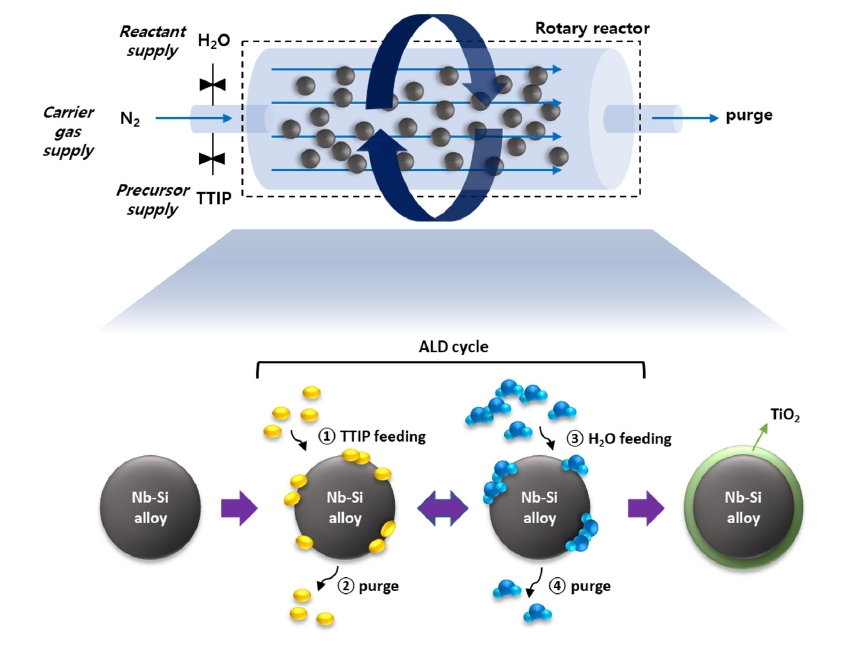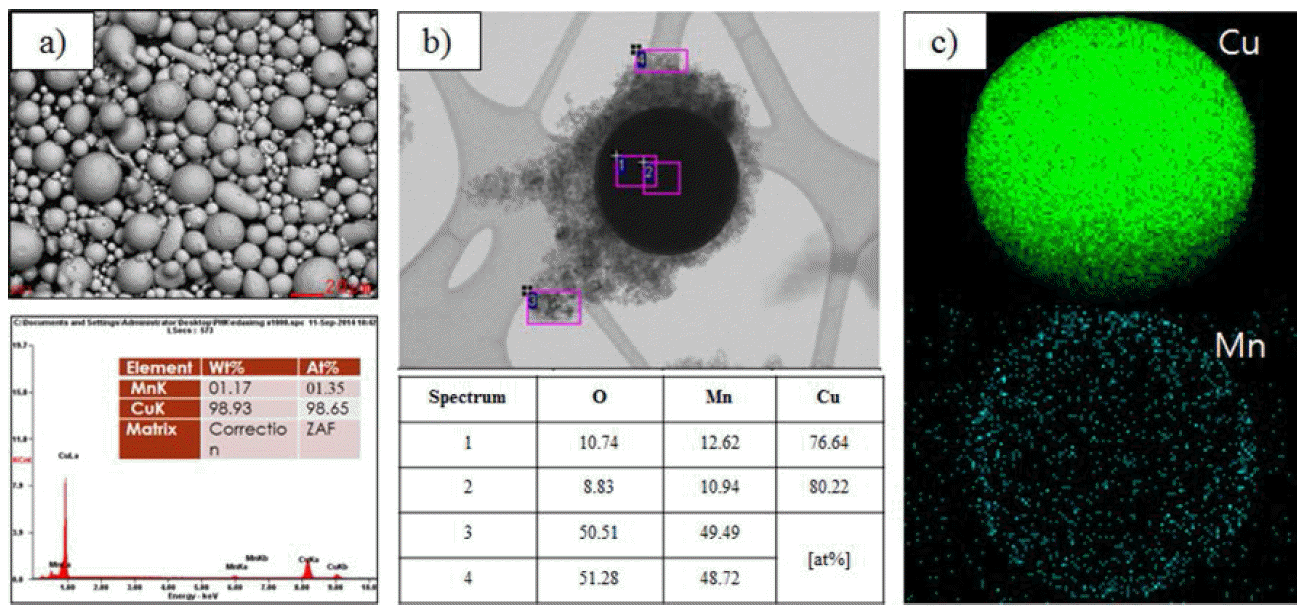Search
- Page Path
- HOME > Search
- [Korean]
- TiO2 Thin Film Coating on an Nb-Si–Based Superalloy via Atomic Layer Deposition
- Ji Young Park, Su Min Eun, Jongmin Byun, Byung Joon Choi
- J Powder Mater. 2024;31(3):255-262. Published online June 27, 2024
- DOI: https://doi.org/10.4150/jpm.2024.00052

- 1,778 View
- 49 Download
-
 Abstract
Abstract
 PDF
PDF - Nano-oxide dispersion–strengthened (ODS) superalloys have attracted attention because of their outstanding mechanical reinforcement mechanism. Dispersed oxides increase the material’s strength by preventing grain growth and recrystallization, as well as increasing creep resistance. In this research, atomic layer deposition (ALD) was applied to synthesize an ODS alloy. It is useful to coat conformal thin films even on complex matrix shapes, such as nanorods or powders. We coated an Nb-Si–based superalloy with TiO2 thin film by using rotary-reactor type thermal ALD. TiO2 was grown by controlling the deposition recipe, reactor temperature, N2 flow rate, and rotor speed. We could confirm the formation of uniform TiO2 film on the surface of the superalloy. This process was successfully applied to the synthesis of an ODS alloy, which could be a new field of ALD applications.
- [Korean]
- The Effect of Diffusion Barrier and thin Film Deposition Temperature on Change of Carbon Nanotubes Length
- Soon-kyu Hong, Hyung Woo Lee
- J Korean Powder Metall Inst. 2016;24(3):248-253. Published online June 1, 2016
- DOI: https://doi.org/10.4150/KPMI.2017.24.3.248

- 469 View
- 1 Download
- 2 Citations
-
 Abstract
Abstract
 PDF
PDF In this study, we investigate the effect of the diffusion barrier and substrate temperature on the length of carbon nanotubes. For synthesizing vertically aligned carbon nanotubes, thermal chemical vapor deposition is used and a substrate with a catalytic layer and a buffer layer is prepared using an e-beam evaporator. The length of the carbon nanotubes synthesized on the catalytic layer/diffusion barrier on the silicon substrate is longer than that without a diffusion barrier because the diffusion barrier prevents generation of silicon carbide from the diffusion of carbon atoms into the silicon substrate. The deposition temperature of the catalyst and alumina are varied from room temperature to 150°C, 200°C, and 250°C. On increasing the substrate temperature on depositing the buffer layer on the silicon substrate, shorter carbon nanotubes are obtained owing to the increased bonding force between the buffer layer and silicon substrate. The reason why different lengths of carbon nanotubes are obtained is that the higher bonding force between the buffer layer and the substrate layer prevents uniformity of catalytic islands for synthesizing carbon nanotubes.
-
Citations
Citations to this article as recorded by- A Study on Residual Powder Removing Technique of Multi-Layered Graphene Based on Graphene One-Step Transfer Process
Chae-young Woo, Yeongsu Jo, Soon-kyu Hong, Hyung Woo Lee
Journal of Korean Powder Metallurgy Institute.2019; 26(1): 11. CrossRef - Fabrication of robust, ultrathin and light weight, hydrophilic, PVDF-CNT membrane composite for salt rejection
Vivek Dhand, Soon Kyu Hong, Luhe Li, Jong-Man Kim, Soo Hyung Kim, Kyong Yop Rhee, Hyung Woo Lee
Composites Part B: Engineering.2019; 160: 632. CrossRef
- A Study on Residual Powder Removing Technique of Multi-Layered Graphene Based on Graphene One-Step Transfer Process
- [Korean]
- Fabrication and Property Evaluation of Cu-Mn Compacts for Sputtering Target Application by a Pulsed Current Activated Sintering Method
- Jun-Ho Jang, Ik-Hyun Oh, Jae-Won Lim, Hyun-Kuk Park
- J Korean Powder Metall Inst. 2016;23(1):1-7. Published online February 1, 2016
- DOI: https://doi.org/10.4150/KPMI.2016.23.1.1

- 950 View
- 1 Download
- 1 Citations
-
 Abstract
Abstract
 PDF
PDF Cu-Mn compacts are fabricated by the pulsed current activated sintering method (PCAS) for sputtering target application. For fabricating the compacts, optimized sintering conditions such as the temperature, pulse ratio, pressure, and heating rate are controlled during the sintering process. The final sintering temperature and heating rate required to fabricate the target materials having high density are 700°C and 80°C/min, respectively. The heating directly progresses up to 700°C with a 3 min holding time. The sputtering target materials having high relative density of 100% are fabricated by employing a uniaxial pressure of 60 MPa and a sintering temperature of 700°C without any significant change in the grain size. Also, the shrinkage displacement of the Cu-Mn target materials considerably increases with an increase in the pressure at sintering temperatures up to 700°C.
-
Citations
Citations to this article as recorded by- Fabrication and Mechanical Property of Fe-20Cu-1C Compacts by SPS process with Different Heating Rate
Jung-Han Ryu, Soo-Sik Shin, Byung-Rok Ryu, Kyung-Sik Kim, Jun-Ho Jang, Ik-Hyun Oh, Kap-Tae Kim, Hyun-Kuk Park
Journal of Korean Powder Metallurgy Institute.2017; 24(4): 302. CrossRef
- Fabrication and Mechanical Property of Fe-20Cu-1C Compacts by SPS process with Different Heating Rate
TOP
 KPMI
KPMI


 First
First Prev
Prev


